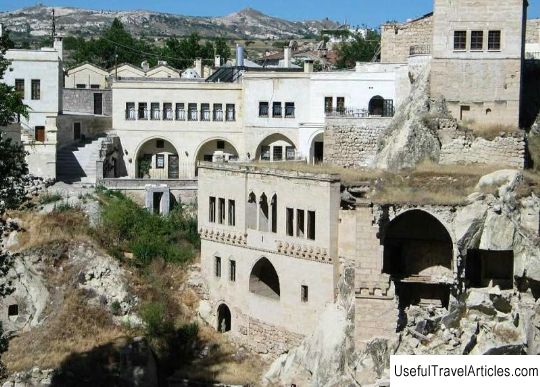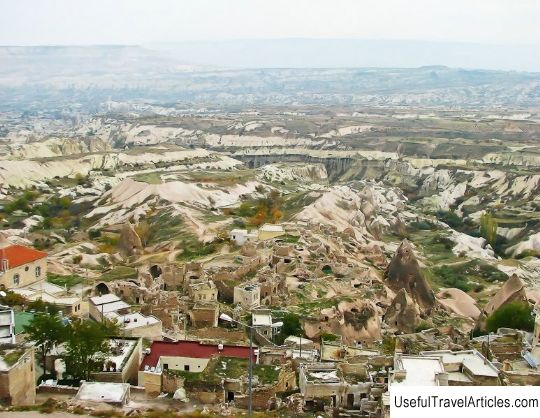Ortahisar description and photos - Turkey: Cappadocia

Ortahisar description and photos - Turkey: Cappadocia. Detailed information about the attraction. Description, photographs and a map showing the nearest significant objects. The name in English is Ortahisar. Photo and descriptionOrtahisar is a large village halfway between Goreme and Yurgup, one kilometer from the Nevsehir-Yurgup highway in Turkey's popular tourist region of Cappadocia. Ortahisar is spread out in a beautiful valley. The locals call it a small village. Sivrikaya - a huge monolith of rock, similar to a tower, rises in the center of the settlement. The entire rock is dotted with passages like a bee hive. The inner rocky chambers were exposed due to landslides that once occurred in the rock. People have lived in them from time immemorial. Translated into Russian, Ortahisar means "Average Fortress". Upstairs you can climb stairs that stretch past dwellings carved into the rocks. Weather permitting, you can see Mount Erciyes, which rises seventy kilometers from here. In the makhalla opposite Yeni, you can see the Jambazly Kilisesi church. It is located on a private property, but its owners do not mind the large number of visitors who come to see the church. The very fact of having a historical landmark in your own courtyard may seem surprising, but for locals it is in the order of things. The "Middle Fortress" is characterized by a number of picturesque, but at the same time simple buildings. The structures in which vegetables and fruits were stored were mainly two-story. To get to the second floor, you need to climb the external staircase, which does not have a parapet. The buildings built in the later period are made of the same hard local stone. Outside, the surfaces of the houses are decorated with simple molding and whitewashed with lime. Ortahisar Fortress, with a height of 86 meters, it was closed to guests six years ago, as it was dangerous to be in the structure. This limitation caused a drop in the level of visits to this region. But now, after the restoration work was completed, which was carried out with the participation of Ankara University and the local government, the fortress was reopened and vacationers can visit it. The city itself also has scenic spots that are definitely worth a visit. A typical example of urban architecture can be found among the houses on the edge of the fortress. The sides of the valley are dotted with cutouts and storage areas that are used to store local produce such as apples, oranges, lemons and potatoes brought from the Mediterranean. Turkey is the land of lemons. Almost a quarter of the citrus crop is still grown in this area. The citrus scent is everywhere here. Near each courtyard there is a mountain of used orange boxes, and in a large, gentle gorge with breathtaking views, there is a vegetable warehouse.Having, for example, lemons in such a storage with a high degree of humidity, they will acquire a bright yellow color and become very juicy. Nearby, huge trucks are loaded in neat boxes. The village itself has retained its national flavor and charm, being considered one of the most foreign-friendly places in Cappadocia, while not too `` spoiled ''; the spirit of profit. The inhabitants of Ortahisar are some of the most welcoming. There is life underground in Cappadocia. Here, both earlier and now, rock massifs continue to be hewn out to create new storage facilities, dwellings and even restaurants in them. The rapid development of tourism has contributed to an increase in the number of catering establishments located underground. Locals call them "kuzu", which translates as "lamb". Tourists love this kind of restaurants very much. They usually serve lamb, cooked on a spit, and show a beautiful folklore show. Urban buildings are extremely simple: the buildings are uniform in shape and almost all have flat roofs. On the local narrow streets, you can still see small four-wheeled carts with plank walls, over the seats of which an awning is installed to protect passengers from the sun. There are very interesting churches and monasteries in the valley surrounding the village. Among them are: Sarija Church, Sambazla Churches, Tarvansla Church, Balkan Deresi Church and Dere Halach Monastery. The Yuksel Halicilic carpet weaving farm in this village weaves carpets, dyes and spins wool, and demonstrates herike weaving techniques to tourists. Immediately there is the Museum of Ancient Carpets and Kilims, a shop selling rare silk carpets, replicas of old woolen carpets, traditional kilims.    We also recommend reading Church of St. Martin (Gross Sankt Martin) description and photos - Germany: Cologne Topic: Ortahisar description and photos - Turkey: Cappadocia. |




